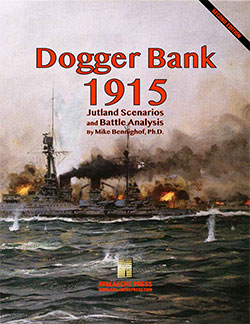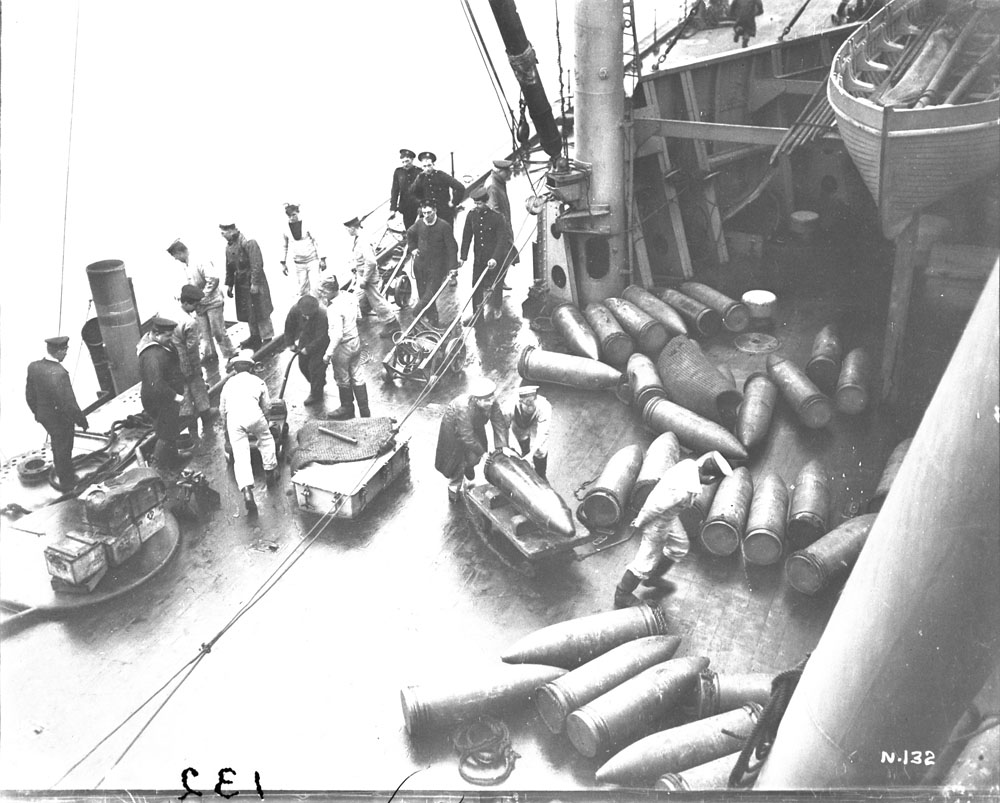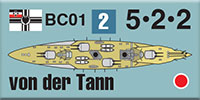| Jutland:
The Battle of Dogger Bank, Part Two
By Mike Bennighof, Ph.D.
November 2024
 The Royal Navy’s command structure in January 1915 promised if anything even greater potential for disaster than that of the High Seas Fleet. The civilian head of the Admiralty, First Lord Winston Churchill, believed himself possessed of a strategic genius superior to that of the admirals who had actually commanded ships and men at sea. First Sea Lord Sir John Fisher had returned to the office in November, and possessed similarly strong though rarely well-thought-out opinions. Finally, former First Sea Lord Sir Arthur Wilson had attached himself to the Admiralty as an unpaid advisor, floating lunatic schemes like an immediate invasion of northern Germany and somehow being taken seriously. The Royal Navy’s command structure in January 1915 promised if anything even greater potential for disaster than that of the High Seas Fleet. The civilian head of the Admiralty, First Lord Winston Churchill, believed himself possessed of a strategic genius superior to that of the admirals who had actually commanded ships and men at sea. First Sea Lord Sir John Fisher had returned to the office in November, and possessed similarly strong though rarely well-thought-out opinions. Finally, former First Sea Lord Sir Arthur Wilson had attached himself to the Admiralty as an unpaid advisor, floating lunatic schemes like an immediate invasion of northern Germany and somehow being taken seriously.
Forced to balance these massive egos, Vice Admiral Henry Oliver, Chief of the War Staff, often simply allowing them all to bloviate before ignoring them and following his own instincts. “Two out of the three,” he noted later, “were always violently opposed to the plan of the third under discussion.” Oliver, the former head of Naval Intelligence, was equally over-confident in his own abilities, but when the Admiralty’s signals intelligence division learned of a pending German foray into the North Sea on 23 January 1915, he reacted decisively. Twenty-five minutes after receiving the decryption, Oliver had orders on their way.
Responsibility for intercepting the German battle cruisers would fall on Sir David Beatty’s battle cruisers, based at Rosyth on the east coast of Scotland. Officers and crews had to be collected and steam raised, but the big ships were under way by 1800, just fifteen minutes after the Germans left their own anchorage. Beatty had two squadrons of battle cruisers, the First with his flagship Lion and her sister Princess Royal as well as their near-sister, the brand-new Tiger. The squadron’s fourth ship, Queen Mary, was refitting. The Second Battle Cruiser Squadron, commanded by Rear Admiral Sir Archibald Moore, a favorite of Churchill who was deeply detested by Beatty, had two older and slower battle cruisers, New Zealand and Indomitable; his third ship, Invincible, was at Gibraltar on her way to join him.

Loading ammunition aboard the flagship HMS Lion.
Beatty ordered a speed of 18 knots, less than desired by his bosses at Whitehall and forcing him to steam through the corner of a potential minefield. Perhaps better than his counterpart Hipper, Beatty understood that as impressive as his ships might outwardly appear, they remained ultimately powered by muscular human arms. Exhausting his stokers before battle, as well as his fuel, might prove disastrous in action. Beatty wanted his black gangs at full strength when the shooting started. Scouting for the battle cruisers would be the four light cruisers of Commodore Sir William Goodenough’s First Light Cruiser Squadron: Town-class ships, larger and more heavily-armed than most light cruisers of the time but not as fast.
Daily Content includes no AI-generated content or third-party ads. We work hard to keep it that way, and that’s a lot of work. You can help us keep things that way with your gift through this link right here.
The battle cruisers initially steamed to the south-east, gradually turning to the east. Two hours after they departed, the Third Battle Squadron, also stationed at Rosyth, followed on a track slightly to their south. Vice Admiral Edward Bradford’s King Edward VII class battleships, known as the “Wobbly Eight,” were the most recent pre-dreadnoughts in the Royal Navy and still considered front-line units by many admirals. Bradford was missing one ship, Commonwealth, undergoing refit but had three armored cruisers of the Third Cruiser Squadron attached for scouting purposes.
The Grand Fleet came out in support as well, but exiting Scapa Flow was a lengthy procedure in the best of times. All three battle squadrons had set out by 2030, aiming for a rendezvous point 150 miles north of Beatty’s expected position. Sir John Jellicoe had 20 operational dreadnoughts, with one (Conqueror) under repair following serious underwater damage from a collision with her sister Monarch. The older dreadnought Superb had left on the 18th for turbine repairs. The two newest dreadnoughts, Emperor of India and Benbow, were still working up but Jellicoe took them anyway, leading to some sources listing the British total at 18 heavy ships rather than 20. In support he had three cruiser squadrons with nine armored cruisers between them, and the Second Light Cruiser squadron of four ships. Twenty-eight destroyers accompanied the fleet.

The Harwich Force flagship Arethusa speeds across the North Sea.
Finally, Commodore Sir Reginald Tyrwhitt’s Harwich Force with a pair of light cruisers and three dozen destroyers was ordered out in support; these were expected to provide destroyer protection for the battle cruisers. They would be the first British units to spot and engage the Germans.
The Germans had steamed through the night with their four heavy ships in column and the torpedo boats fanned out ahead. Two of Hipper’s four light cruisers accompanied the torpedo boats, with the other two on the left and right flanks of the main force. They encountered fishing boats as they approached the Dogger Bank, but could not make out their flags and did not stop to harass them; that would wait for daylight.
When the sun rose, the German cruiser Kolberg found the Harwich Force light cruiser Aurora instead of radio-equipped fishing smacks. Aurora flashed a challenge by signal light; Kolberg replied with a single letter and a salvo of shells, three of which hit the British cruiser. The German ship signaled Hipper almost at the same time that the light cruiser Stralsund steaming ahead of the battle cruisers reported smoke clouds to the north-west and radio traffic as well. Aurora soon hit Kolberg twice and the German cruiser turned away from the action.

HMS Aurora opens fire on SMS Kolberg.
“Am in action with the German fleet,” Aurora reported to Beatty, which amused Beatty’s staff but not the admiral. He ordered the Harwich cruisers and destroyers to form a screen in front of his battle cruisers and continued on. At 0730, twenty-five minutes after her brush with Kolberg, Aurora spotted the German battle cruisers and this time provided a useful report while Beatty’s 1st Light Cruiser Squadron sighted the German light cruisers in Hipper’s screen. Beatty, already on course for battle, made no changes to course and speed.
Believing that he faced only enemy light forces, Hipper likewise pressed forward. But his intelligence section noted the rising volume in British radio traffic, and warned that many of the signals matched those of the Second Battle Squadron encountered in December - super-dreadnoughts far outclassing Hipper’s ships. The growing columns of smoke confirmed that heavy ships approached, and Hipper briefly discussed his options with his flag captain, Moritz von Egidy of Seydlitz. The British were known to have only five battle cruisers available, and Hipper was - probably foolishly - willing to fight them with his three battle cruisers and one oversized armored cruiser. But the six to eight dreadnoughts of Second Battle Squadron, big new ships armed with 13.5-inch guns that outmatched anything the German ships carried, would annihilate the First Scouting Group. At 0735 (0835 by German clocks) he ordered maximum speed (23 knots, with both Blücher and Seydlitz unable to make more thanks to poor-quality coal) and a course reversal back to the south-east. Beatty increased his speed and a stern chase began.
Hipper moved his light cruisers and torpedo boats ahead of his battle line, unwilling to expose them to British heavy gunfire. But he left Blücher at the end of his line. By 0825 the British had come within 16,000 meters, and Hipper ordered Blücher to open fire. The Battle of Dogger Bank had begun.
You can order Jutland: Dogger Bank right here.
The Jutland Saga
 Jutland Second Edition Jutland Second Edition
Jutland: North Sea 1914
Jutland: Dogger Bank
Jutland: Risk Fleet
Retail Price: $233.96
Package Price: $190.00
Gold Club Price: $152.00
You can order the Jutland Saga right here.
Please allow an extra three weeks for delivery.
Sign up for our newsletter right here. Your info will never be sold or transferred; we'll just use it to update you on new games and new offers.
Mike Bennighof is president of Avalanche Press and holds a doctorate in history from Emory University. A Fulbright Scholar and NASA Journalist in Space finalist, he has published a great many books, games and articles on historical subjects; people are saying that some of them are actually good.
He lives in Birmingham, Alabama with his wife and three children. His Iron Dog, Leopold, could swim very well.
Want to keep Daily Content free of third-party ads? You can send us some love (and cash) through this link right here.
|
